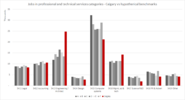Apologies for a long one, this is an interesting topic for me.
Cars & Highways
I don't think the "white flight" and industrial relocation were as tightly correlated in the way you are suggesting. They occurred within roughly the same time periods but were brought on by somewhat disconnected processes. Like everything it's partially connected, but not tightly causal as you implied.
The automotive storyline is one of consolidation, automation and union/corporate power shifting 1900s - 1970s. The outcome of that was corporate power consolidated into the "big three" which destroyed smaller Detroit-based manufacturers through the 1930s, 1940s and 1950s. Factories moved to the Detroit burbs and elsewhere in an increasingly regional/continent-wide distribution network - now one with fewer well-paying middle-management jobs and eventually substantially fewer jobs altogether thanks to automation and further international competition by the 1970s and 1980s. In short, Detroit was increasingly not actually the source of manufacturing, however the city was still a huge labour pool to support the suburban industrial processes, many of which still exist today but with a fraction of their original jobs.
Detroit also then layered on the typical American city approach at the time - tear down functioning neighbourhoods to build giant expressways all throughout the city thanks to cheap federal loans. Being the car industry headquarters certainly didn't lead to much meaningful resistance. This had the same effects as elsewhere - remove economically productive areas to be highways, destabilize neighbourhoods along the way.
White Flight
Industrial disruption and federally-backed suburbanization/highway schemes were all well underway
before the "white flight" began in earnest in the 1950s and 1960s. As for "white flight", I think Canadians underestimate how structural racism was in American at that time in impacting these processes. Populations were rapidly growing in Detroit and it's suburban cities throughout the 1930s and 1940s, but black populations were deliberately (and sometimes violently) blocked from accessing many neighbourhoods through violence, red-lining and restrictions on zoning that prevented sufficient housing.
This and other broader factors led to - and at at risk of dramatically over-simplifying - lots of drama. Detroit saw lots of drama ensured for decades - riots, strikes, racialized violence etc. This cumulated into the 1967 Detroit riots that killed around 50 people and destroyed thousands of businesses. This was no small riot - one of the largest in American history at that time. This was a critical blow and really turned a downturn, into a nose-dive for Detroit - literally hundreds of thousands of people left the city within a few years after, mostly white but some black population too. Collapse of tax base = worse services = less competitive = more people leaving = further collapse in tax base.
Meanwhile, the Detroit region's untouchable economy finally hit the brakes shortly after in the 1970s and 1980s with increasing foreign competition, oil price increases, and the first post-war recessionary periods began. This really meant any urban recovery that was already unlikely, became impossible. The Detroit region continued on with more modest prospects - lots of jobs, produces lots of cars, but it's all incremental growth now. The region is no longer playing the booming economic role that it played for nearly a 75 years in America.
So is Calgary = Detroit? No - it's not possible. While there's lots to learn about discriminatory zoning, industrial job locations, and inter-city competition here, the specific context of Detroit in that time is so vastly different to processes that occurred in our city (and most others for that matter).
If not Detroit, then who? What is Calgary the next version of?
A better example of a "
is Calgary turning out like the next _____" is
Winnipeg. It's far less dramatic of a place, but has more of the structural similarities and for many decades was Canada's 4th largest city, a role we are now firmly in. Similarities:
- Canadian development context
- Main or major gateway city to the prairies, destined to be the "next big city" (Winnipeg = pre-1915 era, Calgary = 2000 - present)
- Concentration into a few major economic sectors (Winnipeg = logistics, trade and railways, Calgary = oil and gas)
- At risk of major disruption (Winnipeg = Panama Canal opening; Calgary = decarbonization and increasing competition from non-fossil fuels)
- Large obsolete monuments to the era when city was booming (Winnipeg = Exchange district of cool art-deco warehouses; Calgary = 1980s - 2010s tall shiny office blocks)
What happened to Winnipeg is it lost it's competitive edge when the Panama Canal opened and it became increasingly easy to ship to the west coast rather than back east. The prairie population boom turned into a bust as rural populations peaked in the early 1900s and it turns out the prairies were never going to see the kinds of population density that was expected (and Winnipeg would never benefit from being the major city servicing a region of millions and millions of people).
The result a prologued, boring, slow-growth phase, but not a collapse - Winnipeg is big enough to keep on moving along regardless. If someone is a pessimist for Calgary's future, that boring, slower, more stagnant scenario is far more likely than outright collapse like Detroit. Not as exciting, but not bad by global standards for the "pessimistic" outcome.






